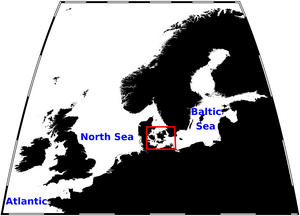Swot tracks significant inflow of oxygen-rich waters to the Baltic Sea
![Sea level from Swot and nadir altimetry during normal state (29-30 December 2023) and at the beginning of the Major Baltic Inflow Event in 2023 (18-19 December 2023) (modified from [Esselborn et al., 2025]). Sea level from Swot and nadir altimetry during normal state (29-30 December 2023) and at the beginning of the Major Baltic Inflow Event in 2023 (18-19 December 2023) (modified from [Esselborn et al., 2025]).](/fileadmin/_processed_/7/c/csm_SWOT_SL_MBI_Esselborn_f11ec5861d.png)

![Vertical stratification and ventilation of the deep layers during normal state and a major Baltic inflow event (modified from [Esselborn et al., 2025]). Vertical stratification and ventilation of the deep layers during normal state and a major Baltic inflow event (modified from [Esselborn et al., 2025]).](/fileadmin/_processed_/7/b/csm_Sketch_SL_MBI_Esselborn_848ea956c5.png)
The Baltic Sea, a shallow, nutrient-rich marginal sea in northeastern Europe, suffers from low oxygen levels in its depths. These depths are only refreshed by infrequent, large inflows of saltwater known as Major Baltic Inflows. For the first time, the Swot satellite captured the sea level dynamics of a Major Baltic Inflow in December 2023 with unprecedented spatial resolution.
The Baltic Sea is characterized by distinct layers of water: a brackish surface layer replenished by rivers and rainfall, and a salty bottom layer originating from the North Sea. While surface water regularly flows out to the North Sea, the deep layers are slow to renew due to the shallow Danish Straits. Renewal occurs primarily during rare Major Baltic Inflow events – lasting one to two weeks and triggered by specific, extreme weather conditions. The most recent Major Baltic Inflows in December 2023 ended a period of stagnation lasting since 2016. These inflows create noticeable changes in sea level between the Kattegat and the western Baltic Sea, along the Danish Straits.
Prior to Swot, observations of Major Baltic Inflow events relied on ship-based measurements, moorings, and tide gauges. While traditional nadir satellite altimetry can measure large-scale sea level changes in the area, its accuracy is limited in the narrow Danish Straits, and it can only capture a one-dimensional view of the event. In December 2023, the Swot satellite captured the sea level conditions at the beginning and end of the inflow event. At scales larger than 50 km, these observations agree with concurrent high-rate multi-mission nadir altimetry and simulations from the operational forecast model for the German coasts. While the model accurately reflects the overall observations, some discrepancies appear on daily and sub-daily timescales, suggesting areas for improvement. Furthermore, Swot data reveal numerous fine-scale features – like eddies and fronts – that are difficult for the model to capture. Although Swot’s sampling rate is not sufficient to fully monitor Major Baltic Inflow events on its own, combining Swot data with high-rate nadir altimetry can significantly enhance existing monitoring systems and potentially improve the accuracy of future model predictions.
Reference:
- Esselborn, S., T. Schöne, H. Dobslaw, R. Sulzbach, 2025: The 2023 Major Baltic Inflow Event Observed by Surface Water and Ocean Topography (SWOT) and Nadir Altimetry, Remote Sensing, vol. 17, no 7. https://doi.org/10.3390/rs17071289




